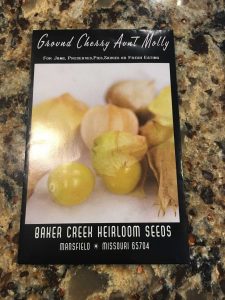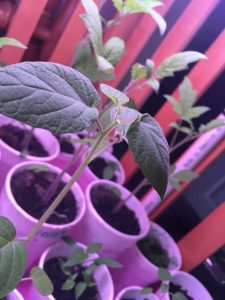**Yes, my seedlings are in an old crib, converted into a desk and now a seed-starting table. Perhaps we are taking the word “nursery” too literally, but it works.
For the last several years, I have kept a small garden in my backyard. The first few years I gardened had more failures than successes, but I managed to grow enough produce that I got a taste for the delight that is homegrown food. I have learned a few more tips and tricks every year, and my garden has grown bit by bit. But, there are three things that have irreversibly changed the way I garden: 1) ordering from seed catalogs, 2) setting up a grow light system so that I could start my own seeds indoors, and 3) purchasing a small greenhouse kit so I could extend my gardening season by a month or so on either side of spring and fall frost dates.
Seed catalogs were the first thing that completely destroyed (in the best way) how I viewed gardening. Since receiving my first catalog in the mail, I’ve come to view these catalogs as one of my very favorite things the United States Postal Service brings to me.
Seed catalogs not only contain thousands of varieties that you’ve likely never heard of before, but they also contain facts and history about plants that were once common and have fallen into obscurity. There are hundreds of different kinds of tomatoes available for sale – more than the Early Girl and Big Boy varieties available locally – and colorful pictures that delight the eye. There are common plants, obscure plants, newly-discovered, old world plants, and there are recipes that make you just interested enough to take a risk and try something new.
My all-time favorite seed catalogs are from Baker Creek Heirloom Seeds and Seed Savers Exchange.
I learned from the first seed catalog I ever received that garlic is best planted in the fall. This little tidbit prompted me to try growing garlic for the first time, and I ended up learning a lot about death and resurrection in the process (and harvesting so much garlic that I was able to share it far and wide).
And, it was from a seed catalog that I first learned about ground cherries.
Ground cherries are like tomatillos – little fruits wrapped in papery husks – but smaller and sweeter. I had seen them growing wild on the walking path behind my house, but before seeing the bright yellow fruits in the picture in my seed catalog, I had no idea what they were or that they were edible. I learned that they were something people along the Oregon Trail foraged for when rations were tough to come by. I’ve since heard people talk longingly about ground cherry jelly and ground cherry pie. I also learned that they are somehow like a tomato, but with the flavor of a pineapple. Basically, I knew just enough that I knew I had to try and grow some, but I had never tasted one before and had no idea if I would even like them.

Two years ago I ordered some Aunt Molly’s ground cherry seeds, and I tried to start some indoors. They germinated right away, but were tall and spindly. They quickly flopped over the edge of the cups I was growing them in, withered, and died. I was so disappointed. I did some research on why plants get tall, leggy, and weak, and found that it was probably a combination of not enough light and no wind. It turns out that starting seeds in the house means simulating wind so that plants will have just enough stress to strengthen their stalks. If that’s not a metaphor for life, I’m not sure what is.
This year, I purchased a fluorescent grow light from a local home improvement store, and I got a little fan to simulate wind. I ordered some more Aunt Molly’s ground cherry seeds, and I planted them indoors. My seedlings are almost two months old now, and the first blossoms are starting to form. In a couple of weeks, I’ll be able to move them outside to the garden.

I’m hoping this will be the year that I finally get to taste a ground cherry, and even if I don’t like how they taste, I’m pretty sure it will be immensely satisfying. Since seeing a picture in a seed catalog two years ago, I haven’t been able to stop wondering what they were like.
Seed catalogs wreck you with the possibilities of things you never before knew were possible.
And, the truth is, that connects me spiritually somehow with God who knows the things that are possible within me before I even know them about myself.
I started out gardening because I wanted fresh produce. Then I expanded my garden because I wanted to grow things I couldn’t buy locally. But, gardening is becoming for me an increasingly spiritual endeavor as I seek to reconnect with the soil – and the One who commissioned us to tend and keep it. As I’ve done that, I’ve found myself filling up with a desire to grow and nurture all the beautiful things – both the things I find in the seed catalogs, and the neglected beautiful things latent within myself and others.
I can’t wait to watch all of it grow.

